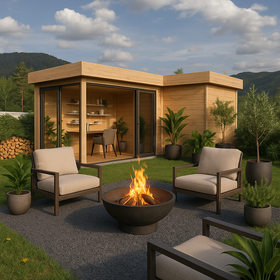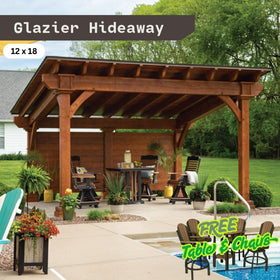512-777-0154

What Is a Louvered Pergola?
So, you’ve probably seen them around—those sleek outdoor structures popping up in backyards and patios. But what exactly is a louvered pergola?
Simply put, a louvered pergola is a pergola with adjustable slats on its roof. These slats—called louvers—rotate to let sunlight in or block it out. Think of it as blinds but for your patio roof.
In this article, we'll go deeper. We'll break down exactly how these structures work and why people seem to be installing them everywhere lately.
What Is a Louvered Pergola?
A louvered pergola is just like a regular pergola—except smarter.
Instead of having a fixed, open roof like traditional pergolas, this one comes with adjustable slats on top. These slats are called louvers, and they can tilt open or shut depending on how much sun, shade, or airflow you want. You get the look of a classic pergola but with way more control over your outdoor space.

Traditional pergolas are fine if you're after some filtered sunlight and don't mind getting rained on. But if you want something a little more functional, louvered pergolas take things up a notch. Open the louvers for a breeze. Close them when it starts drizzling. It’s a small change that makes a big difference.
It’s no surprise they’re catching on. They look sharp, they’re built to last, and they actually do something useful.
Related: 15 Easy Ways to Elevate Your Fun Outdoor Living Space
Let’s Talk About Those Louvers
Louvers are the moving slats on top of the pergola. Think of them like horizontal blinds—but overhead.
They can tilt open to let sunlight and air through or close to give you shade and shelter. When closed fully, they form a solid cover that can even keep out light rain. Pretty handy when the weather changes mid-barbecue.
Manual versions use a crank. Motorized ones usually come with a remote or wall switch. Some even connect to smart home systems, if you’re into that sort of thing.
Most louvers are made from powder-coated aluminum. It’s lightweight, doesn’t rust, and stands up to the weather. Some models use steel, composite, or even wood, but aluminum is the most common—and the most low-maintenance.
In short, louvers are what make the pergola adjustable. And that’s where the real value comes in.
Manual vs. Motorized: What’s the Difference and Why Should You Care?
Once you’ve wrapped your head around what a louvered pergola is, the next question usually pops up fast: should you go manual or motorized?
Both do the same thing—they adjust the louvers to open or close. The difference is how they do it. One’s more hands-on. The other’s more hands-off.
Manual Louvered Pergola

Manual systems use a simple crank or handle. Turn it one way, the louvers open. Turn it the other, they closed. That’s it.
There are no motors, no wires, and no electricity involved. Fewer moving parts means fewer things that can break down over time. That also tends to mean a lower price tag upfront.
Manual louvered pergolas are a solid choice if you’re working with a smaller space or want to keep costs under control. They do the job well and don’t need much maintenance.
One trade-off: you’ll need to physically adjust the louvers each time you want to change the angle. So if you're the kind of person who doesn’t mind giving a handle a quick spin now and then, this option works just fine.
Motorized Louvered Pergolas

Motorized versions are powered—either by electricity or solar panels. Press a button and the louvers move on their own. Some models even come with remotes, wall switches, or smartphone apps.
Feeling extra? Some systems include rain or wind sensors that automatically adjust the louvers for you. For example, louvers can close on their own when it starts to rain. So you don’t have to sprint out mid-dinner to crank them shut.
Motorized pergolas are usually more expensive, both in terms of the product and installation. They also need a power source, which could mean hiring an electrician depending on your setup.
But the trade-off is convenience. No manual effort. No getting up. Just tap and relax.
In short, manual is simpler. Motorized is easier. It really depends on how much you value automation—and how often you think you’ll adjust the louvers.
How Does Louvered Pergola Work?
Here’s where we get into the nuts and bolts. But don’t worry—it’s simpler than it sounds.
Louvered pergolas work using a series of pivot points that let the slats (or louvers) tilt open and close. These pivots are connected to a mechanism—either a manual crank or a small motor—that adjusts the angle. Most systems let the louvers rotate up to 180 degrees. That means you can go from full sun to full shade, or anywhere in between.

In motorized models, small electric actuators handle the movement. Press a button, and the louvers glide into position. It’s quiet, smooth, and takes all of two seconds.
Now, here’s something clever. When the louvers close completely, they form a watertight surface. Built-in gutters along the frame catch the rain and direct it through hidden channels, usually out the sides or down the posts. No dripping. No surprise puddles.
Some higher-end models go a step further with smart tech. Rain sensors can close the louvers automatically when bad weather rolls in. Wind sensors can even lock them in place if things get too gusty.
So while the structure might look simple from the outside, there’s a bit of engineering under the hood that keeps everything running smoothly.
Why Do People Love These Things?
Let’s be honest. People don’t spend extra money on a pergola just for looks.
Yes, a louvered pergola does look good. But that’s not the only reason it’s showing up in more backyards, patios, and rooftop spaces.
It’s the mix of comfort, control, and convenience that makes it stand out. You’re not just buying a structure. You’re adding function to your space—without making it feel over-designed or overbuilt.
Here’s what actually makes these things worth it.
1. Total Control Over Sunlight and Shade
Fixed-roof structures give you one option. Either it’s covered or it’s not.
A louvered pergola gives you choices. You control how much sunlight comes in—whether you want full sun, filtered light, or complete shade. All with a twist of a handle or a tap on a remote.
Got harsh afternoon sun? Angle the louvers to block it. Want morning light while you sip coffee? Tilt them the other way.
It’s this kind of flexibility that makes it easy to use your outdoor living space year-round. Whether it's mid-July or early fall, you can adjust your setup to suit the day.
In hot climates, it can even help keep your patio cooler. In milder areas, it adds just enough cover to make shoulder-season lounging comfortable.
You don’t have to pick between sun or shade anymore. You get both, whenever you want.
2. Rain? No Problem
One of the biggest perks? Weather protection when you need it.

When the louvers are fully closed, they form a tight seal overhead—basically turning the pergola into a solid roof. Rainwater doesn’t drip through. Instead, it’s directed into built-in gutters that run along the frame. From there, it channels down through the posts and away from your space.
It’s not just convenient—it’s smart.
This means you don’t have to rush inside when the weather turns. You can keep the grill going or finish your drink without sprinting for cover.
And if you’ve gone with a motorized model, some systems even detect rain and close the louvers for you. So you’re covered even when you’re not around to adjust things yourself.
3. Boosts the Value and Style of Your Space
Let’s talk about curb appeal.
A louvered pergola adds structure, texture, and clean lines to your outdoor setup. It frames the space without boxing it in. And because the louvers can open up, it keeps the area feeling airy—not heavy.
That’s the design side.
On the real estate side, adding a usable outdoor living area can increase your home’s perceived value. Buyers see it as a lifestyle upgrade, not just a nice-to-have feature. Especially when it’s built well and looks intentional—not like an afterthought.
It’s the kind of thing that photographs well too, which doesn’t hurt if you’re ever thinking about listing your place down the line.
So whether you’re staying put or planning ahead, this kind of upgrade checks both boxes: it looks good and it adds value.
4. Low Maintenance, High Durability
If the idea of regular upkeep makes your eyes glaze over, good news—louvered pergolas are built to last without needing much from you.

Most models use powder-coated aluminum for the frame and louvers. Why does that matter? Because aluminum doesn’t rust, peel, or warp. It stands up to sun, rain, and wind without falling apart after a few seasons.
It also doesn’t need to be repainted or resealed every year. A quick rinse with a hose and maybe a soft brush is usually all it takes to keep it looking sharp.
Some designs use steel or composite materials, and a few lean into natural wood. But for durability and ease of care, aluminum tends to win out.
You’re getting structure without the stress. Which is kind of the whole point, right?
A Smarter Shade Solution That Actually Does More
By now, you’ve got a solid grip on what a louvered pergola is—and why people are choosing it over the usual backyard structures.
It’s not just about looks. It’s about control. You decide how much sun, shade, or shelter you want. And you don’t need to compromise when the weather changes halfway through your afternoon.
Whether you’re dealing with heat, light rain, or just trying to make your patio more usable, this setup gives you options. Without a full renovation. Without constant maintenance.
So if you’re thinking about making your outdoor space more functional, a louvered pergola is a smart place to start.
Curious about how to choose the right one? Or how does it compare to other options? We’ve got more guides to help you figure that out. Check our blogs for more outdoor living guides.
And if you’re ready to take a closer look, feel free to browse our outdoor living furniture. You might find exactly what your space has been missing.



